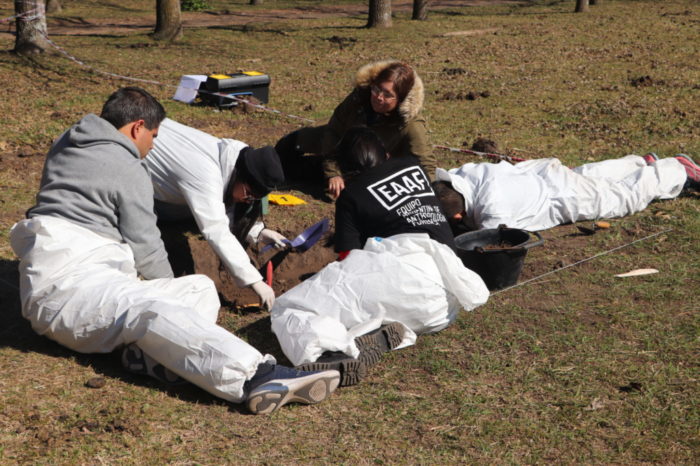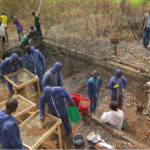Forensic Guide to the Investigation, Recovery and Analysis of Human Skeletal Remains

This Forensic Guide to the Investigation, Recovery and Analysis of Human Skeletal Remains was published within the context of Project “Promoting Justice for the Extrajudicial Killings and Enforced Disappearances in Colombia, Peru and Guatemala”, conducted by the International Commission of Jurists (ICJ), in partnership with the Asociación Red de Defensores y Defensoras de Derechos Humanos (Network of Human Rights Advocates Association) (Colombia) and the Equipo Argentino de Antropología Forense (EAAF), to promote accountability and reparation in cases of extrajudicial killings and enforced disappearances. For its Guatemalan and Peruvian chapters, the project has relied on the cooperation of the Fundación de Antropología Forense de Guatemala (FAFG) and the Equipo Peruano de Antropología Forense (EPAF).
It is important to note that, beyond their similarities, the search for victims of enforced disappearance in the three countries has evolved along different paths. In some cases, it has been characterized by the strong presence of the state (as in Colombia and, to a lesser degree, Peru); in others, as in Guatemala, the state has been completely absent. At the same time, it should be underlined that search processes in the three countries have never been linear. In the case of Colombia, the search was carried out during domestic conflict, whereas in Guatemala and Peru this process started after violence was over (in 1992 and 2002, respectively).
Objective
The objective of the forensic guide is to provide a practical and simple tool for cases that involve the investigation, recovery and analysis of human skeletal remains for purposes of identification and determination of cause of death in contexts of human rights violations and infringement of international humanitarian law.
These cases are very often dealt with by state institutions specialized in ordinary criminal cases or mass disasters, which leads to errors at different phases of the investigation. This guide is therefore intended to address complex cases in which the perpetrator is not an individual but state officials, parastatal forces or rebel groups.
It is not designed to replace any existing manual on the subject prepared by institutions or any academic textbook on the matter, but to serve as a common action protocol for all organizations performing forensic tasks, both at the official and non-official levels, in Colombia, Peru and Guatemala.
It is important to highlight that these three countries have a more than 20-year forensic tradition devoted to this type of cases, which means that much of what is stated in this document has become daily practice in their respective forensic areas.
The guide is also intended to reach diverse target audiences. On the one hand, lawyers, judges, prosecutors, the police, and forensic teams, but also families of victims and their associations. As the audience is heterogeneous, plain language was used, free from any technicality or complex words.
The guide is based on the Minnesota Protocol on the Investigation of Potentially Unlawful Death (2016), but it is mainly devoted to forensic aspects and cases involving skeletal remains rather than fresh or decaying corpses.
It aims at pointing out the minimum elements of the investigation in each of its phases, without purporting to exhaust all the possibilities available. Thus, institutions implementing it will find it easier to reach consensus on working methodologies and the use of common forms, as well as to adapt the guide to each particular context.
This guide somehow reflects 35 years of uninterrupted forensic practice in Latin America, involving complex cases, different judicial systems and an intermittent interaction with state agents responsible for conducting investigations, such as lawyers, judges, prosecutors, police forces and forensic experts.
Victims’ Families
The guide has taken into account the perspective of the family members of those affected by violence, their constant fight for truth and justice, and the resourcefulness they have had to develop over time to interact with institutions that are reluctant to carry out a prompt, independent and effective investigation.
The participation of the victims’ relatives in the investigation process has gained ground in the three countries, with differences according to their respective context. Therefore, it is also the purpose of this guide to spread knowledge and foster exchange between two sectors usually kept separate and at opposite poles: justice operators and victims’ family members. However, the persistent work of the human rights organizations has undoubtedly been the main engine to urge states to investigate and prosecute the perpetrators of crimes under investigation. This has been crystal clear in the three countries.
On many occasions, reference is made to the “participation” of the victims’ relatives in these processes, without mentioning however what that participation means. There have been many different modes of participation, but in our opinion, the victims’ families and their organizations should sit at the table where the political decision as to the type of mechanism to be used for search purposes is taken.
We believe that, while the tasks of recovering bodies or gathering antemortem data should not fall within the relatives’ sphere of responsibility, they should however be informed about legal and technical procedures as well as authorized to make consultations, have access to forensic reports, pose questions to the forensic experts involved, challenge them by resorting to their own forensic experts if they do not agree, and dispose of the bodies as they wish. To take the victims’ family members merely as passive antemortem data givers is undoubtedly a frequent mistake.
Violence and its Consequences
One of the most evident and negative results of the violence that swept across Latin America in the last 60 years was the enforced disappearance and death of thousands of people. From Mexico up to Argentina and Chile, violence took very different forms —it was typically perpetrated by military dictatorships that seized power by overthrowing legitimately elected governments (Brazil, Uruguay, Chile, Argentina, Guatemala, among others), but also civilian governments inflicted it (as in Mexico, Colombia and Peru).
With the return of peace and democracy, the search for, recovery and analysis of bodies became key elements in the transition towards democratic rule. The relatives of victims of enforced disappearance and violence played a key role in making the new governments take action and investigate past events. The so-called Truth Commissions and the actions taken by the judiciaries were basic mechanisms implemented by the region for that purpose. In turn, the regional system of justice, under the Organization of American States (OAS), as well as the Inter-American Commission on Human Rights and the Inter-American Court of Human Rights, with their investigations and rulings, played a fundamental role in the process.
On the forensic side, new mechanisms had to be adopted given the situation. A lack of trust in public forensic experts in many countries combined with a lack of experience with skeletonized bodies gave rise to new forensic initiatives outside the scope of the state, namely EAAF, FAFG, EPAF, and others in Chile, Uruguay, Colombia and Mexico.
With the passing of time, the forensic practice, which until then had remained unrelated to the wishes, needs and rights of the victims’ relatives, started to incorporate a “social” component, thus conferring credibility and transparency to processes lacking these essential components in the past.
It is in this context that, in 1991, a group of legal and forensic experts gathered by the University of Minnesota prepared the so-called “Minnesota Protocol” (Manual on the Effective Prevention and Investigation of Extra-Legal, Arbitrary and Summary Executions (1991)), which was approved by the United Nations. This protocol was updated in 2016 and describes the minimum standards required for investigations into cases such as the ones that were beginning to be investigated in the region.
In 2020, several decades after the events, investigations are still underway to find the victims of enforced disappearance and killings in different Latin American countries, particularly in Colombia, Peru and Guatemala. The experience gained and the achievements made have been important, as in some cases they have contributed to devising a work method that is applicable to similar contexts of violence in other parts of the world.
However, thousands of persons are yet to be found and it is imperative that those responsible for investigating and administering justice be equipped with common practical tools, such as the ones provided by this guide, in order to help them improve their investigations and their response to the victims’ relatives.















